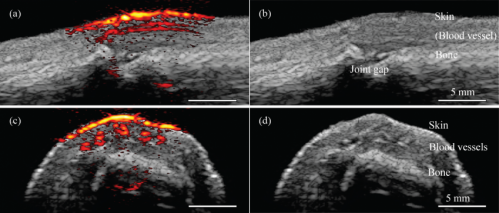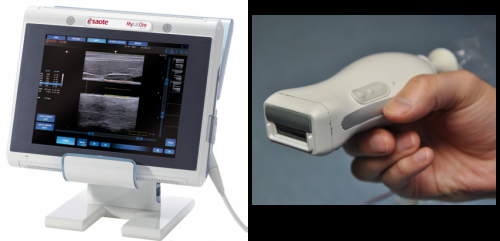Handheld probe produces detailed images of blood vessels, other internal body parts

A new handheld probe developed by a team of university and industry researchers in the Netherlands and France could give doctors powerful new imaging capabilities right in the palms of their hands. The imaging system, which is described in a paper published in The Optical Society's (OSA) open-access journal Optics Express, shrinks a technology that once filled a whole lab bench down to a computer screen and a small probe about the size of a stapler.
The new device combines two imaging modalities: ultrasound and photoacoustics. Ultrasound is a well-established technology that analyzes how sound pulses echo off internal body parts. It is good at revealing anatomical structures and is, perhaps most familiarly, used to image a developing fetus in a mother's womb.
Photoacoustics is a relatively new imaging technique, still making its way toward widespread clinical applications. In photoacoustic imaging, short pulses of light heat up internal tissue. The slight temperature change leads to a change in pressure, which in turn produces a wave of ultrasound that can be analyzed to reveal information about the body's internal workings. Since this technique ultimately produces ultrasound waves as well, existing technology can be used to analyze and display the images.
The advantage of photoacoustics is that it can reveal important medical information that other imaging techniques cannot, including the presence of molecules like hemoglobin and melanin and the sub-millimeter structure of networks of blood vessels several centimeters beneath the skin. When combined with spectroscopic measurements, photoacoustics can also quantify hemoglobin oxygen saturation within single vessels, providing metabolic information that could be helpful for monitoring tumor progression, for example.

Yet despite these benefits, the cost and size of most photoacoustic systems limit their widespread use, said Khalid Daoudi, a researcher in the Biomedical Photonic Imaging Group at the University of Twente in the Netherlands. Most systems on the market require costly and bulky lasers that make the systems impractical for point-of-care diagnostics. "Our research aimed to break through these hindering factors," Daoudi said.
The project started as collaboration between the University of Twente and three European companies: ESAOTE Europe, a maker of medical diagnostic systems, Quantel, a maker of solid state lasers, and SILIOS Technologies, a maker of optical components.
The team's key innovation, which allowed them to dramatically shrink the system, was the design of an ultra-compact laser based on an efficient and inexpensive laser diode. By stacking multiple diodes to increase the power and carefully designing optical elements to shape the laser beam, the team was able to generate laser pulses with energies higher than had ever been achieved before with diode technology.
Diode lasers can also provide many laser pulses per second, which in turn allows real time imaging, another advantage of the new system, Daoudi noted.
The researchers tested the imaging performance of the system in different types of phantoms—materials designed to mimic a tissue's optical properties—and in a healthy human finger joint.
The new compact probe and imaging system can be easily transported between rooms in a clinical setting, an attractive feature for future commercialization, the researchers said.
The team is currently working with a European consortium of industrial and academic partners to take the next steps from the research to the commercialization phase. The current system operates at a single wavelength in the near infrared, but the team has plans to expand the design to multi-wavelength imaging.
"Some applications targeted are rheumatoid arthritis in finger joints, oncology, cardiovascular disease and burn wounds," Daoudi said.
More information: "Handheld probe integrating laser diode and ultrasound transducer array for ultrasound/photoacoustic dual modality imaging," K. Daoudi et al., Optics Express, Vol. 22, Issue 21, pp. 26365-26374 (2014). dx.doi.org/10.1364/OE.22.026365
Journal information: Optics Express
Provided by Optical Society of America





















